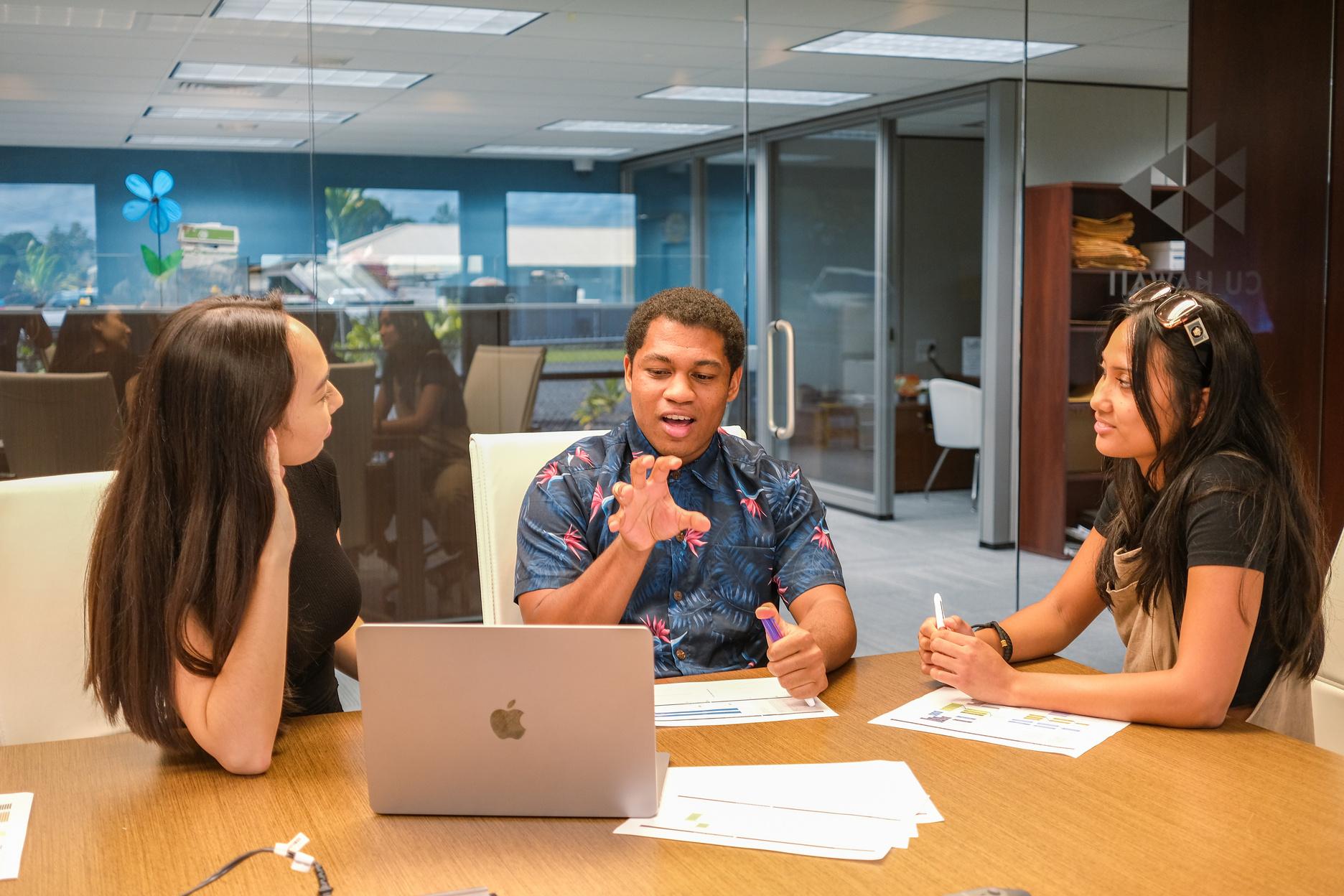PREPARING TO HOST INTERNS
A planning guide for organizations and employers

A collaborative project of the Workforce & Professional Development Core Team








A decision tree to determine if an internship is really the best choice for your organization
Thinking through your goals and purpose for offering an internship
Centering your internship on the students and their needs using an equity lens

This Planning Guide was created by the Vibrant Hawaiʻi Workforce & Professional Development Core Team after hosting conversations with multiple organizations who had developed effective and long-lasting internship programs in Hawai’i. Their learning was so impressive that, with their permission, we felt compelled to share it out with our community.
With the increase in need for work-based learning opportunities for our youth, and the definition of a "good job" including one that makes people feel valued, we know that these approaches can help all of us, whether we are thinking of starting a new internship, or improving a long-lasting one!

To determine whether pursuing an internship is the best form of work-based learning for your organization, consider these two key questions.
QUESTION 1
What is the time capacity of my organization? Can we offer something longer-term, or would a one-day or onetime experience be more doable?
QUESTION 2
What is our staffing capacity to oversee and mentor an intern?
If you answered that your organization might be better doing a onetime experience and/or has low staffing capacity, there are many other options for offering work-based learning experiences.

With limited time, there are still a lot of great ways to connect with our young people and offer workbased learning experiences!
Serve as a classroom guest speaker
Give informational interviews to students potentially interested in your field
Serve as a judge or reviewer for student competitions or portfolios, providing constructive feedback for them
An excellent resource to learn more and connect with students is the ClimbHI Bridge
Job shadowing - this allows a young person thinking about your field to spend a day with you to get a better idea of what it is really like Host a group of students at your workplace to give a tour and see it from an insider’s viewpoint
Community service projectsinvite a group of students to join on a project that contributes to your field Resume/Interviewing development - offer to read and conduct mock interviews, offering insider feedback specific to your industry

Thinking through your real goal in offering a work-based learning experience is the first step in designing an effective internship for both your organization and the intern. Following are 5 common goals for offering an internship.
01
To provide a shortterm training site
Particularly for those organizations who have the ability to offer a site and mentorship, but not future employment, they might excel as short-term training sites. An example would be a 2-week intersession training for 20 people in event planning every year that prepares them to work at other companies that require that skill. Hosting it before a large event allows the host site to get help in the execution and planning of their event as well.
02 To offer an on-ramp to a permanent job
You may be having a challenging time finding good employees and want to start an internship program to build a pathway into employment. Hosting an intern can allow both you and the intern to have some time to decide if the job and environment is right for them, and if their work ethic and style is right for your business or organization.
To build the skill set for a particular industry
Your organization might excel in green energy, and want to help build the capacity for growth in this new market in the area.
05
To give back to your community or specific industry
After growing a successful business in a specific area of Hawaiʻi Island for many years, you want to build opportunities for young people from your community, or for young people interested in entering your industry.
04
To create systems change
A different goal is one of systems change. The Akamai program has a mission to provide particularly women in STEM fields positive experiences so that they can be competitive in traditionally male-dominated environments. Because systems change is their big goal, it shapes what is included in the program to give our young people not just the skills needed, but also training for employers on how to craft the experience in a way that welcomes a more diverse workforce.




Who you want to serve will determine other aspects of what you offer, how it’s structured, and how you communicate it out to the community.
College Students
Those connected to human services
Retraining
For example, HIWEDO Huiana serves high school students, which then led them to consider aspects such as transportation, how to give students school credits, and the legal requirements of working with those who are not legally yet adults.
Your target population will also impact how you communicate your internship out and what partnerships you will want to build to find great candidates.
Full-time or part-time?
Summer or year-round?
As mentioned earlier, your target population may determine some of these answers. High school and college students can probably commit 40 hours a week during the summer months, but not during the school year, whereas those in retraining will most likely want full-time work yearround.

Is there someone with the capacity and skill set to mentor an intern?
What support would that employee need to be successful?
Easily the most underestimated aspect of the internship is the time needed for an employee to effectively mentor an intern.
It is typically much more work on the side of the organization at the beginning, but the more investment of training that can be made, the more the intern will be able to do to help the organization. This is the area that often leads to a disappointing experience for both the intern and the organization unless it is planned out well in advance.
There is a lot of flexibility in how you think about this question. An organization without funding to pay an intern might consider using an intermediary, like Kāpili ‘Oihana or Dragon Den, or offer a shortterm project that will allow someone to build a specific set of skills and make it worth their time. In this sense, you are offsetting the lack of pay with your expertise and mentorship.
If you are able to offer a paid internship, we encourage you to do so. It opens up the opportunity to those students who cannot afford to volunteer because they have financial need or are currently filling a caregiving role in their families which, if left, will create an additional bill for the family to pay. We are in a time when volunteer work is still asked for on many different applications, such as scholarships, but not all of our community members have the ability to do unpaid work.
U.S. Department of Labor Fact Sheet #71
Are there other supplies to support the intern's professional advancement?
Employers may offer supplies such as steel-toed shoes or scrubs that interns will need to be successful in their desired field, which can help offset an unpaid internship.

Just as important as understanding your own business or organization’s “why” and purpose for hosting an intern(s), is acknowledging the intern’s own “why” and their hopes for pursuing an internship at your site. It is important to consider and uplift a student-centered, equityfocused perspective when thinking about how you would present yourself as an internship site (and employer overall) to a new generation of workers.
Some questions we prompt you to consider are the following:
What is the unique value that your internship will provide and how might that align with what interns are seeking?
What type of culture and environment will your site foster and how might that align with the identities and needs of the interns?
How might your site environment allow for the interns to thrive and grow in their personal and professional development in alignment with their goals?

Below are some questions to consider that could help you build a deeper understanding of interns’ goals, both professional and personal. As you consider the various questions, please note: we are all here to learn and not knowing answers to a question does not mean that you and/or your company are non-inclusive or culturally inappropriate. Rather, each question is designed to gently test our readiness and grow our awareness of new topics and languagesome of which might not even have existed five years ago.
We would encourage even providing an opportunity for interns to answer some of these questions directly in a pre-survey format before the start of the internship. Knowing these answers could allow you to shape an experience that would be mutually beneficial and meaningfully impactful for both parties (interns and hosts).
Fulfillment/Sense of Purpose:
Is the intern committed to staying in Hawai‘i (‘oiwi leadership) and flexible about their career goals?
Are they pursuing certain fields because of a desire to serve? I.e. Social Services, Healthcare, Education, Law.
Do they have a desire to help one or more underserved populations? I.e. women of color, kupuna, single dads, non-native speakers of English
Have they researched the company and feel that they align with the mission and vision of the organization?
Have they or their family received critical assistance from this field in the past and now they wish to give back? I.e. social services, Food Bank, scholarships, Habitat for Humanity.
Inclusion/Sense of Belonging:
In what ways do they prioritize diversity and equity in their personal environment?
Please describe a workplace environment that supports your unique needs.
Which interactions help to create a sense of belonging for them?
I.e. Love Languages in the Workplace, Nā Hopena Aʻo, using their identified pronouns.
Which behaviors can sometimes cause them to feel less included? I.e. using discriminatory or insensitive language.
What does equity mean to you and in what ways would you like extra support?
Career
What career do they want to pursue?
What position are they shooting for in order to earn a specific income level?
What specific field are they pursuing because it provides the lifestyle they want?
In contrast, are they in their exploration stage and they are going to pursue multiple internships? If so, in what fields?
Academic/Lifelong
What have they studied?
What do they love to keep learning about?
What classes or events have they engaged in outside of school that sparked an interest that they continued, or wanted to continue, afterward?
What type of problems do they like to solve?
Centering student experience:
Hawaiʻi Public Schools - Nā Hopena Aʻo Statements
8 Interview Questions About Diversity and Inclusion Every Job Seeker Should Be Able to Answer - The Muse
How a DEI Leader at Automattic Creates a Culture of Allyship
Other resources:
Hawaiʻi Work-based Learning Continuum
“A Good Job in Hawai’i” Framework
Gayle Ishimaru, Huiana Student Internship program of HIWEDO
Sharon Ziegler-Chong & Mina Viritua Jr., Pacific Internship Programs for Exploring Science (PIPES)
Lisa Hunter, Akamai Work Initiative & Internship Program
Kei-Lin Cerf, Dragon Den
Heidi Dangaran, Kāpili ‘Oihana, Kamehameha Schools
Workforce and Professional Development Core Team Members:
Kei-Lin Cerf
Rebecca Choi
Lori Ferrin
Caroline Landry
Susan Maddox
Julie Mowrer
Dana Petteys
Paoakalani Shook
Kamela Souza
Special thanks to Cole Fuertes for the beautiful design!